“‘Tis the season to be raspy, cough cough cough cough cough HACK cough cough cough.” Sore throats and flus and colds abound. There are all sorts of remedies on the market, and we like the promise of feeling better when we feel crummy, but I’m a little wary of pouring all sorts of meds down our throats. Maybe I’m deluding myself, but I figure the fewer meds I take for stuff like that, the fewer I’ll need overall.
There are some natural cough drops we like on the market, but you ought to know by now that I’m pretty fond of doing it myself if for no other reason than bragging rights. The catch, when I do stuff like this, is that I often find myself adding to my list, because my guys like the homemade version better than the store bought version. Homemade Cough Drops {lemongrass + ginger} are no exception.
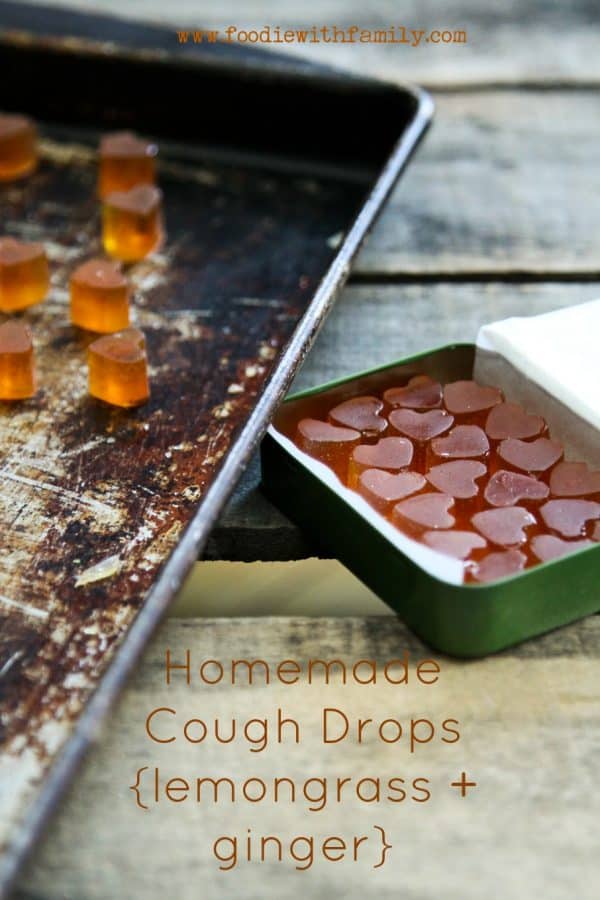
They are herbal and lemony and taste of honey. They’re perfectly perfect for soothing your throat without tasting sickeningly sweet, although my guys PERSIST in calling it throat candy and somehow all develop dreadful sore throats that require near constant cough drops whenever I have a batch of these that are done.
I’m not going to lie. You’re basically making hard candy when you make these, so there are a couple of places it can go wrong. Don’t fear, though, I’m going to walk you through it in my cook’s notes, so you can make Homemade Cough Drops {lemongrass + ginger} like a pro. I’ll help minimize the chances that you’ll have to soak a pan of hardened sugar or end up with a pot of messy honey goo. (But if you DO end up with messy honey goo, just stir it into tea. All will not be lost!)
Let’s get on it with it, because the Homemade Cough Drops {lemongrass + ginger} Cook’s Notes are extensive.
Cook’s Notes
- The base for these Homemade Cough Drops {lemongrass + ginger} is a VERY strong tea that would be unpleasantly stiff to drink. You can make this with fresh lemongrass or dried, but I do advise using fresh ginger to infuse it. It has more oomph.
- You will make your life far easier if you use a calibrated candy thermometer for this job. It doesn’t have to be a bells-and-whistles thermometer, just a simple-under-$10 number like this one on Amazon. The advantage of the one I just linked to is that it can be used for deep frying AND candy making. The reason it’s important is it’s wicked hard to tell whether it has reached just that perfect temperature (302°F, to be exact) without a thermometer, and it is surprisingly specific. A couple of degrees too low and your mixture might look right and might set up, but will stick to your teeth like crazy. Is that bad? Not necessarily unless you’d like to keep any dental work or eat it very carefully, taking care not to let it rest against your teeth. A couple of degrees too high, and you’ll find yourself with a pan full of scorched sugar syrup that needs to be soaked off.
- If you already own a candy thermometer, you’d be well advised to check whether it’s properly calibrated before using it. This is FAR easier than it sounds. Simply put the thermometer in a pan full of water at a rolling boil. It should read 212°F. If it doesn’t, make a note of what it DOES say while the water is boiling and use that number to determine what temperature on your thermometer would be the equivalent of 302°F. For example, if your thermometer reads 199°F while in boiling water, you’ll want to consider your cough drop candy done when it reaches 290°F.
- I love these tiny little heart molds that are made of silicone. Two molds are the PERFECT size for a single batch of Homemade Cough Drops {lemongrass + ginger}. If you don’t want to order them, you can fill a cake pan with confectioner’s sugar and make indentations in it with a small round object (like a 1/4 or 1/2 teaspoon measure). When you pour the hot syrup over the confectioner’s sugar it will pour into the indentations and form little lozenges. Whether you use the molds or the sugar, have it ready to go before you begin cooking.
- Choose a larger pan than you think you’ll need for boiling the candy mixture. I use a minimum of 3 quart size, but prefer a 4 quart size because the mixture expands greatly as it boils. It’s also important that you use a pot with a heavy bottom for more even heat distribution.
- For stirring your mixture, I advise a heat-proof silicone spatula like this one, because it does a good job of scraping the bottom of the pan as you stir to prevent scorching without getting hot to the touch.
- Speaking of the boiling process, it’s going to feel like it takes For. Ev. Er. to get to the 300°F territory. Watch out, though, because once it does, it’ll be done in the blink of an eye. That’s why you need to have your molds/sugar ready before starting.
- When you stir the boiling mixture, please take care to stir the bottom carefully, making sure that you get the whole base of the pan. At the same time, do not scrape the sides of the pan as you stir because you do not want to re-incorporate any crystals that have formed on the sides. That will create a brittle final product with weird crystallization.
- Speaking of pouring the hot syrup, I usually pour the syrup into a Pyrex measuring cup before moving toward the molds or confectioner’s sugar. The pouring spout gives me more precision on aiming boiling hot sugar syrup, which is pretty desirable in my book.
- When using my adorable little heart molds, I use my heat-proof silicone spatula to help coax the syrup across the molds and into the indentations. By doing this, I minimize the amount that doesn’t make it into lozenge shapes.
- Let the Homemade Cough Drops {lemongrass + ginger} firm up, uncovered, for several hours or overnight before unmolding. When they’re done, you can leave them as is, or toss with confectioner’s sugar for a little more staying-separate-power. I load up little tins lined with parchment for my husband and kids and only store the Homemade Cough Drops {lemongrass + ginger} in a single layer. If you want to stack more than one layer, please be sure to put a sheet of parchment or waxed paper between the layers to prevent sticking.
Phew. There it is. I know there’s a lot of fussiness here, but it’s so worth it. Are you going to take the plunge and try making your own Homemade Cough Drop {lemongrass + ginger}?
Connect with Foodie with Family
facebook | pinterest | instagram
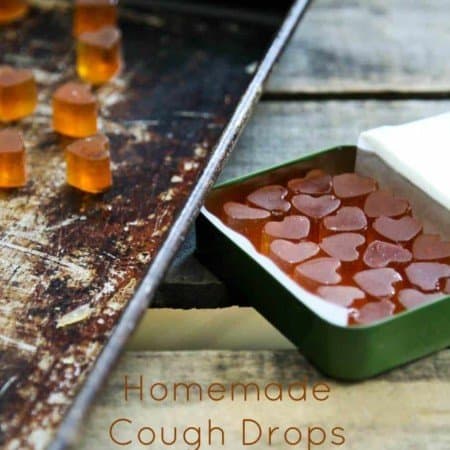
Homemade Cough Drops {lemongrass + ginger}
Rate RecipeIngredients
To make the lemongrass + ginger tea:
- 1/2 cup dried or fresh lemongrass. If using fresh smash it with a meat tenderizer to release the juices before adding to the water.
- 3/4 cup chopped fresh ginger root smashed with a meat tenderizer to release the juices.
- enough water just to cover the ingredients in the pan.
Additional ingredients for the Homemade Cough Drops {lemongrass + ginger}:
- 1 cup of the lemongrass + ginger tea
- 1 cup granulated sugar
- 1/2 cup honey
Instructions
To Make the lemongrass + ginger tea:
- Add the lemongrass and ginger to a pan with a tight fitting lid. Add water just to cover and bring to a boil. Place the lid on the pan, remove from the heat, and let steep for 10 minutes. Strain well. Measure 1 cup of the lemongrass + ginger tea (reserving any additional tea for later batches of cough drops.)
To Make the Homemade Cough Drops {lemongrass + ginger}:
- Lay out whichever molds you plan on using on a rimmed, heat-proof baking pan.
- Add the 1 cup of lemongrass + ginger tea to a large, heavy-bottomed pot over medium-high heat. Stir in the sugar and honey, add the candy thermometer to the bottom of the pan, and stir until the sugar is dissolved. Bring the mixture to a boil, stirring well (avoiding the sides of the pot) from time to time. Watch the candy thermometer. When the mixture reaches about 250°F, stir almost constantly, taking care to stir up the bottom well and still avoid the sides. When it reaches 302°F, carefully pour into silicone molds or a confectioner's sugar mold. Let cool several hours or overnight before unmolding. Toss with confectioner's sugar if desired. Store in a single layer in an airtight container at room temperature.
Nutrition
Nutritional information is an estimate and provided to you as a courtesy. You should calculate the nutritional information with the actual ingredients used in your recipe using your preferred nutrition calculator.
did you make this recipe?
Make sure to tag @foodiewithfam on Instagram and #hashtag it #foodiewithfamily so I can check it out!
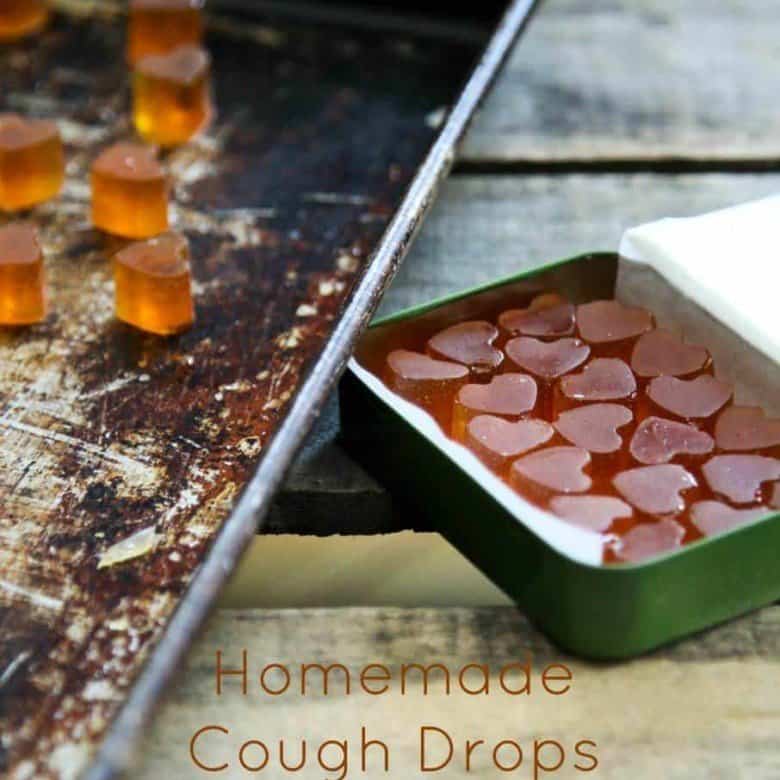
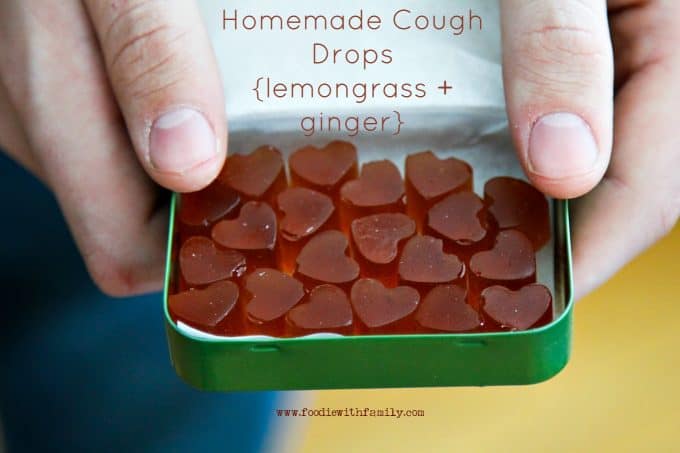
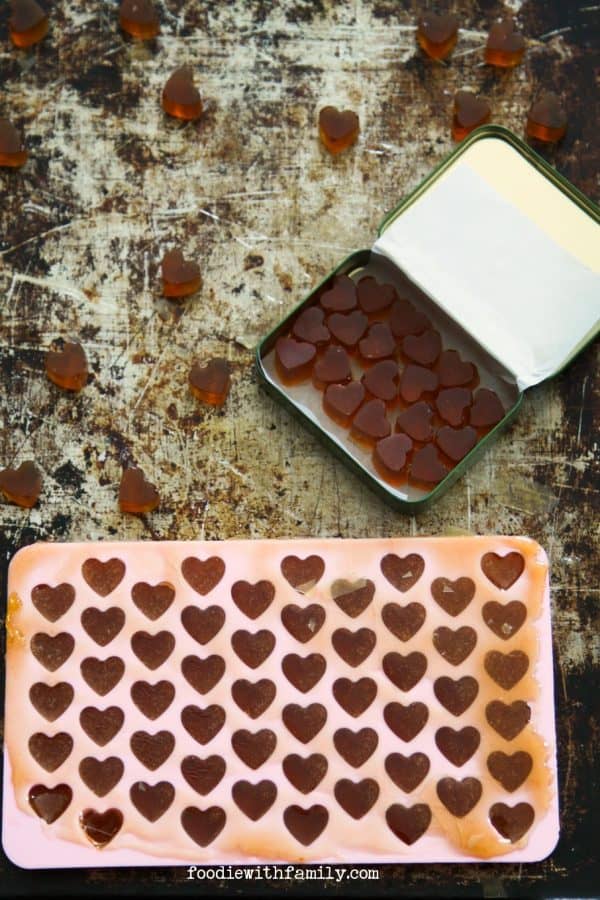
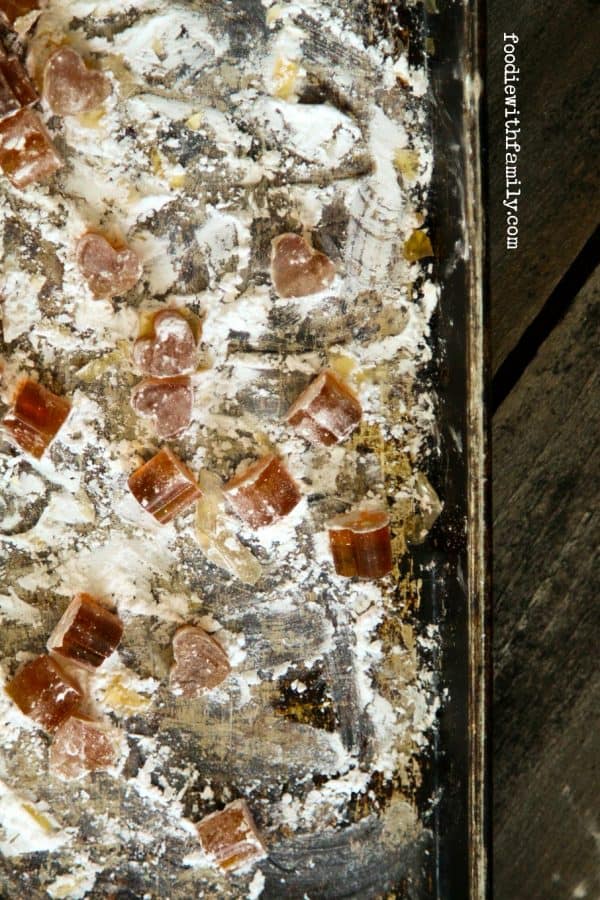



Reader's Thoughts...
Tina says
How long can you store these?
Rebecca says
I’m afraid I have a non-answer for you, Tina! It depends on many factors like relative humidity, temperature, the container in which you’re storing it, and more. A week is probably a good bet so long as you have them in a single layer and an airtight container in a room with a relatively steady temperature.
Colleen says
By heating the honey does it not lose its potency or effectiveness
Rebecca says
It still soothes the throat beautifully!
kristin berry says
The recipe calls for dried or fresh lemon grass. Does that mean powdered lemon grass?
Rebecca says
Hi Kristin! When I say dried lemongrass, I mean dried pieces of lemon grass. I don’t advise you to use powdered lemongrass!
Emily says
For my tea I an using green tea leaves, grated ginger and clove. Do you think that will work?
Rebecca says
Hi Emily- That sounds delicious! I have not tried it, but theoretically it should work quite well!
Rylee says
Hey there I can’t wait to try this recipe. Just curious if you think I could sub monkfruit sweetner for the granulated sugar? I’d like to try and see what happens.
Rebecca says
Hi Rylee- I would not sub something in for the sugar, personally, as I haven’t tested it. And sugar provides part of the structure in the candying process. 🙂